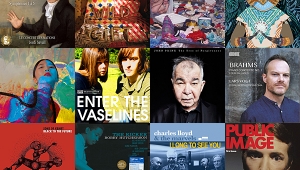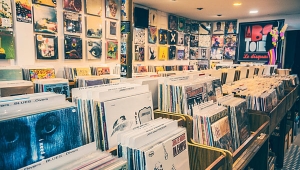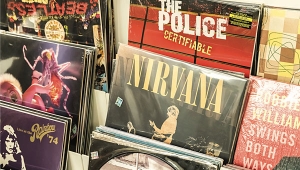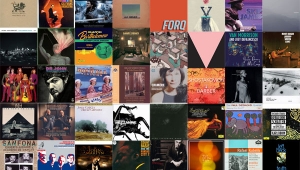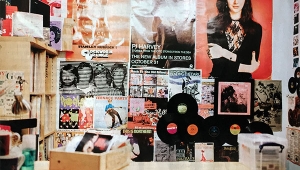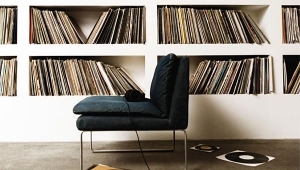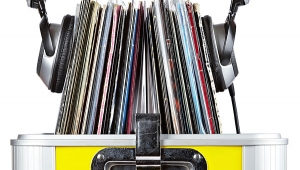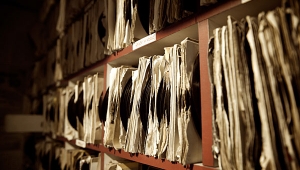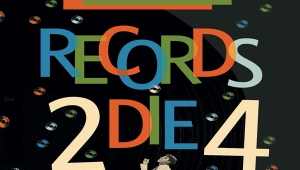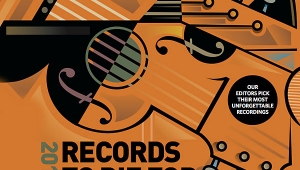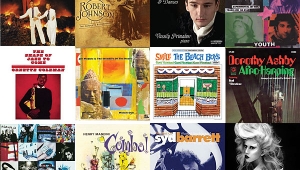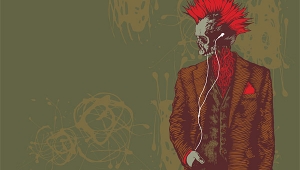| Columns Retired Columns & Blogs |
1999 Records To Die For Page 9
Hyperion Knight
ERNST LEVY: Forgotten Genius
Beethoven: Piano Sonatas 29 & 32. Liszt: Sonata in b, Benediction de Dieu dans la solitude, Spasolizio, Hungarian Rhapsody No.12. Levy: Pieces for Piano
Ernst Levy, piano
Marston 52007-2 (2 CDs). 1998. Scott Kessler, prod.; Ward Marston, eng. ADD. TT: 2:33:55
The little-known Swiss pianist Ernst Levy will finally receive the recognition he deserves thanks to the efforts of Ward Marston and Marston Records, the new label devoted exclusively to Marston's exquisite remasterings of vintage recordings. Like those of most listeners interested in the "golden age" of performing, Marston's tastes run to the outré. His label features pianists—such as Josef Hofmann and Emil von Sauer—who represented the status quo a few decades back, but whose interpretations, were they suddenly to reappear on stage today, might wind up being investigated by a special prosecutor.
BARTÓK: Piano Music
Max Levinson, piano
N2K 10028 (CD). 1998. Elizabeth Ostrow, prod.; John Newton, eng. DDD. TT: 63:56
Max Levinson is a young pianist with a sensitive, highly individual touch. He has been beautifully recorded by N2K in his first two records, the second of which is this disc of Bartók's most famous piano works. The playing is not only energetic and rhythmic, as one would expect in Bartók, but also lyrical and occasionally ruminative. The warm, atmospheric recorded sound adds a certain elegance to this highly charged music, and Levinson's decision to include some of the simpler but charming pieces based on folk tunes makes this a richly satisfying recording.
BOB DYLAN: Live 1966: The "Royal Albert Hall" Concert
The Bootleg Series, Vol.4
Columbia/Legacy C2K 65759 (2 CDs). 1998. Jeff Rosen, prod.; Mr. M. Claydon, Vic Anesini, engs. AAD. TT: 95:18
The electric half of this legendary, oft-bootlegged concert may have been the most important gig in rock history, but that's not to say it was the best. It's dramatic, exciting, appalling, but less like great art than like film footage of an actual battle. For me, whatever made the plugged-in set so crucial just wasn't captured on tape.
THE BEACH BOYS: The Pet Sounds Sessions
Capitol 8 37662 2 (4 CDs). 1966/1997. Brian Wilson, prod.; David Leaf, co-prod.; Mark Linett, co-prod., eng. ADD. HDCD. TT: 4:16:21
The Beatles' Rubber Soul inspired Pet Sounds, which in turn inspired Sgt. Pepper's, and Brian Wilson's finest moment has never sounded better than in this ultimate completist's wet dream of a boxed set. In addition to a CD's worth of session fragments and outtakes, Pet Sounds unfolds here in five different complete versions: the first-ever stereo mix; instrumental backing tracks only; vocal tracks only; alternate takes only; and the original mono mix, remastered in HDCD.
THE KLF: The White Room
KLF Communications JAMS LP006 (LP). 1991. The KLF, prods.; Mark "Spike" Stent, eng. AAD? TT: 45:05
You might have some difficulty finding this album. It sold in vast quantities back in 1991-92, whereupon (on May 14, 1992) The KLF formally dissolved itself, stating that "All our past releases are deleted." The Black Room sequel might remain unfinished, but The White Room is well worth seeking out, even seven years on. Arch-anarcho-Dadaists Bill Drummond and Jimmy Cauty probably invented the arts of sampling and re-mixing, using them with a creativity that more than made up for limited songwriting skills.
NIRVANA: Unplugged in New York
Geffen GEF 24727 (LP). 1994. Nirvana, Scott Litt, prods.; Stephen Marcussen, eng. AAA. TT: 51:10
The music business seems to hold live albums in low esteem—convenient contract fillers to bang out when the muse is elusive and the sales season looms. I couldn't disagree more. Sure, there've been some abject horrors, but when I trawl back through more than 30 years of record collecting, the live albums are the ones most likely to get pulled out and played. Among the recent and readily available, few can match MTV's Nirvana Unplugged—New York sessions from 1993 (published 1994) that make a fine live-and-acoustic counterpoint to the group's essential electric Nevermind, and a fitting memorial to one of rock's briefest and brightest flames. Kurt Cobain's fragile voice sends shivers through the nervous system more painful even than the subsequent loss of his songwriting talents, even if the musicianship can at times be naïve and heavy-handed.
ERNST LEVY: Forgotten Genius
Beethoven: Piano Sonatas 29 & 32. Liszt: Sonata in b, Benediction de Dieu dans la solitude, Spasolizio, Hungarian Rhapsody No.12. Levy: Pieces for Piano
Ernst Levy, piano
Marston 52007-2 (2 CDs). 1998. Scott Kessler, prod.; Ward Marston, eng. ADD. TT: 2:33:55
The little-known Swiss pianist Ernst Levy will finally receive the recognition he deserves thanks to the efforts of Ward Marston and Marston Records, the new label devoted exclusively to Marston's exquisite remasterings of vintage recordings. Like those of most listeners interested in the "golden age" of performing, Marston's tastes run to the outré. His label features pianists—such as Josef Hofmann and Emil von Sauer—who represented the status quo a few decades back, but whose interpretations, were they suddenly to reappear on stage today, might wind up being investigated by a special prosecutor.
Marston hopes to repair this situation by championing unique visionaries of the past, and Levy is among his heroes, heard here in good-sounding recordings from the 1950s. Unlike many "romantic" pianists, Levy's repertoire is quite serious, and his profound, searching performances of Beethoven and Liszt sonatas will be a revelation to those who have never heard him before. His tempos are generally quite broad, and his tone is not always the most refined, but I'm not sure that any pianist has ever probed so deeply the depths of Beethoven's last sonata.
BARTÓK: Piano Music
Max Levinson, piano
N2K 10028 (CD). 1998. Elizabeth Ostrow, prod.; John Newton, eng. DDD. TT: 63:56
Max Levinson is a young pianist with a sensitive, highly individual touch. He has been beautifully recorded by N2K in his first two records, the second of which is this disc of Bartók's most famous piano works. The playing is not only energetic and rhythmic, as one would expect in Bartók, but also lyrical and occasionally ruminative. The warm, atmospheric recorded sound adds a certain elegance to this highly charged music, and Levinson's decision to include some of the simpler but charming pieces based on folk tunes makes this a richly satisfying recording.
![]()
Richard Lehnert
BOB DYLAN: Live 1966: The "Royal Albert Hall" Concert
The Bootleg Series, Vol.4
Columbia/Legacy C2K 65759 (2 CDs). 1998. Jeff Rosen, prod.; Mr. M. Claydon, Vic Anesini, engs. AAD. TT: 95:18
The electric half of this legendary, oft-bootlegged concert may have been the most important gig in rock history, but that's not to say it was the best. It's dramatic, exciting, appalling, but less like great art than like film footage of an actual battle. For me, whatever made the plugged-in set so crucial just wasn't captured on tape.
Maybe that's because Columbia's engineers caught it in the first set, which is the true R2D4 here: just Dylan, his acoustic guitar and harmonica, that inimitable voice and style, an audience as reverently hushed as, one hour later, it would be snarlingly spiteful—and definitive versions of some of this century's most powerful songs. Best are "Visions of Johanna" and "Desolation Row," here in their apocalyptic entireties. The mono sound is almost unbearably, intimately vivid, and Dylan—unlike his performance in the electric set—has nothing to prove, placing himself wholly in service to the songs. His voice was never more flexible, his singing never more dreamlike or incantatory, his phrasing never more starkly tender, or more teasingly insistent that you hear every word. This is the real edge-of-your-seat stuff—so quietly, determinedly true to itself that it demands every ounce of your attention. Great art. (XXII-1)
THE BEACH BOYS: The Pet Sounds Sessions
Capitol 8 37662 2 (4 CDs). 1966/1997. Brian Wilson, prod.; David Leaf, co-prod.; Mark Linett, co-prod., eng. ADD. HDCD. TT: 4:16:21
The Beatles' Rubber Soul inspired Pet Sounds, which in turn inspired Sgt. Pepper's, and Brian Wilson's finest moment has never sounded better than in this ultimate completist's wet dream of a boxed set. In addition to a CD's worth of session fragments and outtakes, Pet Sounds unfolds here in five different complete versions: the first-ever stereo mix; instrumental backing tracks only; vocal tracks only; alternate takes only; and the original mono mix, remastered in HDCD.
Beach Boys aficionados and rock fans in general have for 30 years bowed to that original mono mix. But with all due respect to "the way Brian cut it," my R2D4 here is the stereo remix, made under Brian's supervision. Pet Sounds was an 8-track recording, and Brian often mixed down all nonvocal parts to a single track, leaving seven open for laying down vocals; engineer/co-producer Mark Linett had plenty of space to play with. The result is a vocal sound rich, lush, and spacious even by Beach Boys standards, and absolutely convincing as a pop confection. The mono mix will always have its righteous fans; to me, Pet Sounds now sounds as if Brian wanted it heard in stereo all along. (XXI-3)
![]()
Paul Messenger
THE KLF: The White Room
KLF Communications JAMS LP006 (LP). 1991. The KLF, prods.; Mark "Spike" Stent, eng. AAD? TT: 45:05
You might have some difficulty finding this album. It sold in vast quantities back in 1991-92, whereupon (on May 14, 1992) The KLF formally dissolved itself, stating that "All our past releases are deleted." The Black Room sequel might remain unfinished, but The White Room is well worth seeking out, even seven years on. Arch-anarcho-Dadaists Bill Drummond and Jimmy Cauty probably invented the arts of sampling and re-mixing, using them with a creativity that more than made up for limited songwriting skills.
A string of dance-music hit singles crossed over into the mainstream charts, but the albums were much more reflective and experimental. The White Room is unlike anything else in my collection, and (unlike other KLF material) is very sit-down-and-listen-able. The digital nature of the production and "instrumentation" can be a tad mechanical, but the subtlety and complexity of the arrangements, in what is essentially a "concept album," still have wit and freshness today. Contrived it may be, but it's indisputably artful and exceedingly crafty, and marks an important milestone in the evolution of today's sounds.
NIRVANA: Unplugged in New York
Geffen GEF 24727 (LP). 1994. Nirvana, Scott Litt, prods.; Stephen Marcussen, eng. AAA. TT: 51:10
The music business seems to hold live albums in low esteem—convenient contract fillers to bang out when the muse is elusive and the sales season looms. I couldn't disagree more. Sure, there've been some abject horrors, but when I trawl back through more than 30 years of record collecting, the live albums are the ones most likely to get pulled out and played. Among the recent and readily available, few can match MTV's Nirvana Unplugged—New York sessions from 1993 (published 1994) that make a fine live-and-acoustic counterpoint to the group's essential electric Nevermind, and a fitting memorial to one of rock's briefest and brightest flames. Kurt Cobain's fragile voice sends shivers through the nervous system more painful even than the subsequent loss of his songwriting talents, even if the musicianship can at times be naïve and heavy-handed.
My vinyl copy suffers from warping and an off-center hole—the consequent wow is a pain—and the miking might have been better. But the relatively small, intimate acoustic is much better suited to a live recording than are large, stadium events. (XVIII-3, 5)
- Log in or register to post comments

